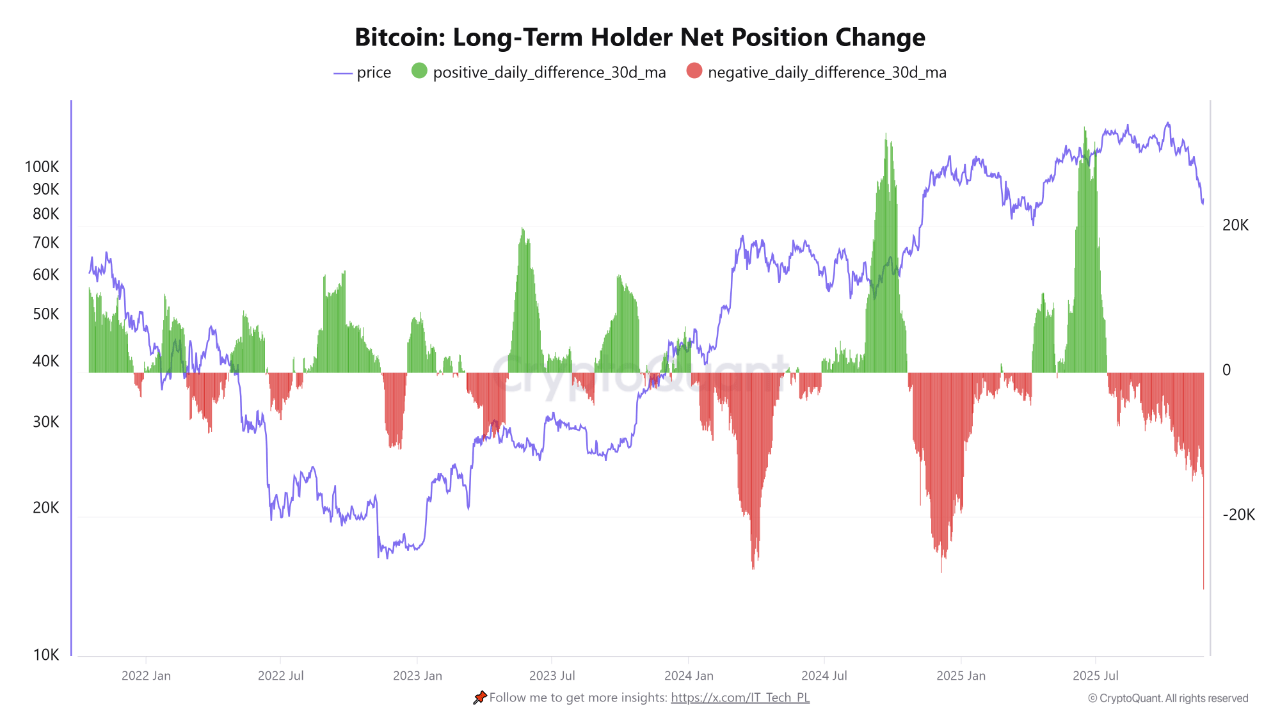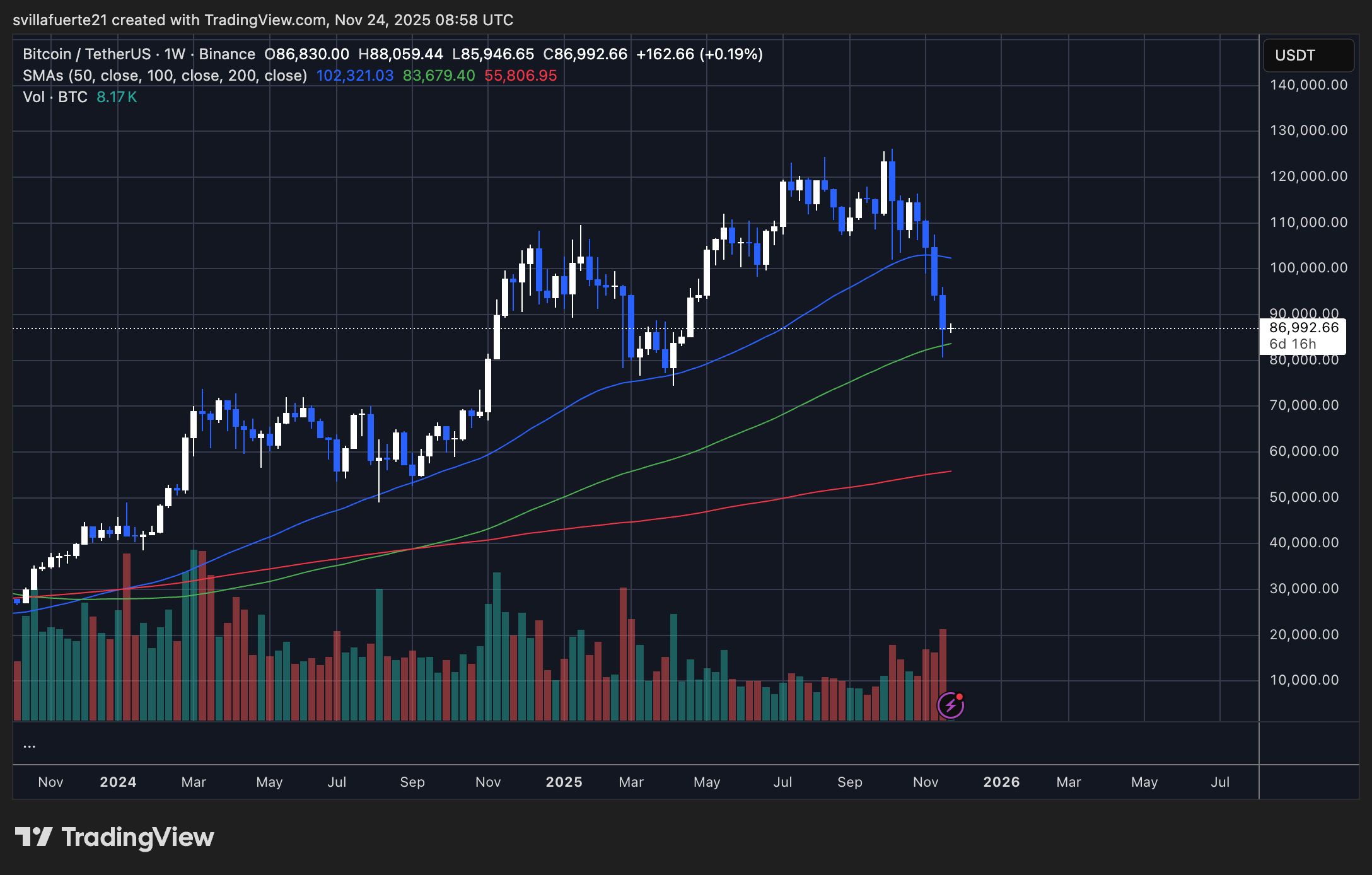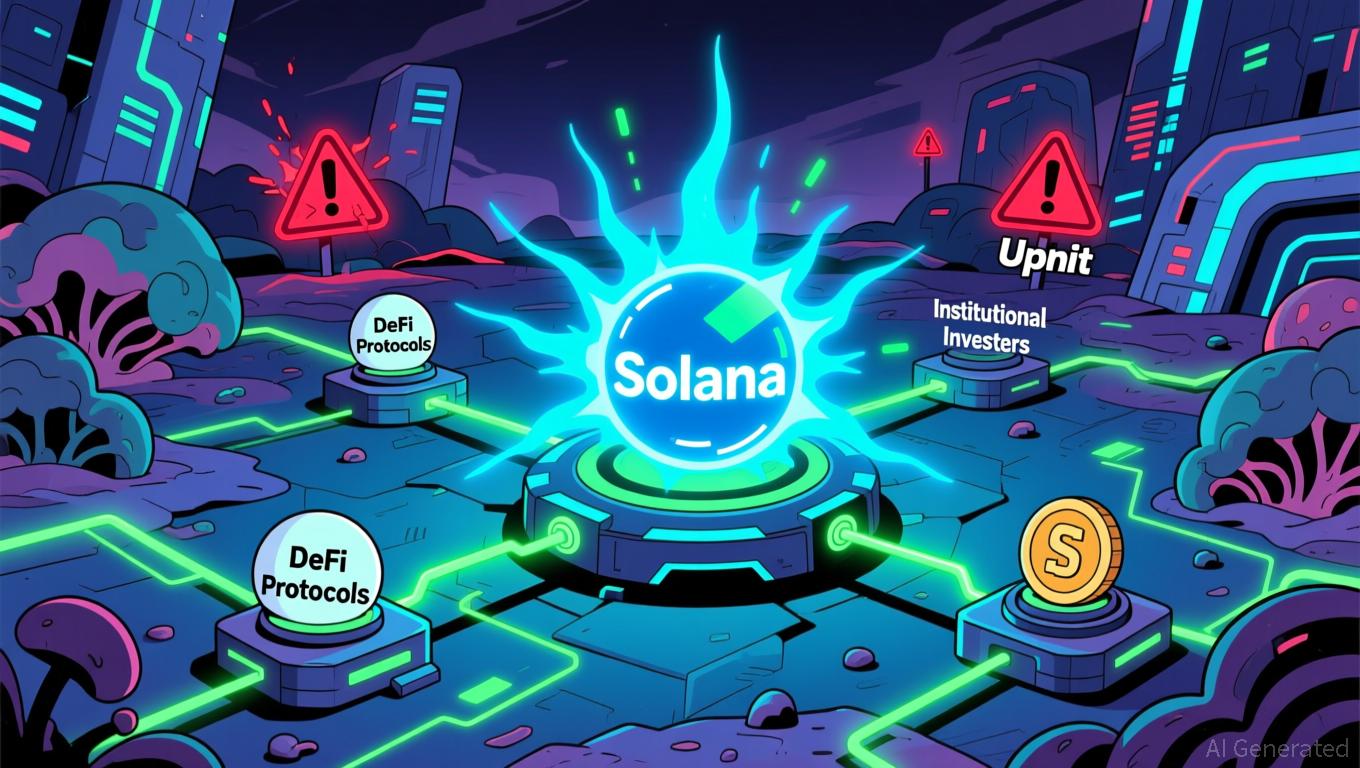63K Bitcoin Exits Long-Term Wallets: A Surge of Speculative Short-Term Buying
Bitcoin is struggling to reclaim momentum as it trades below the critical $90,000 level, with selling pressure dominating the market and fear spreading rapidly. Many analysts are leaning toward calling the start of a new bear market, arguing that Bitcoin likely topped in early October near $126,000. Momentum has weakened sharply since then, and investor behavior now reflects a shift toward risk-off positioning.
A new report from CryptoOnchain, published via CryptoQuant, highlights one of the most significant developments of this cycle: a historic 63,000 BTC has moved from long-term holders (LTHs) to short-term holders (STHs). This unprecedented transfer is clearly visible in the Long-Term Holder Net Position Change chart, which shows a massive red bar — a negative daily difference signaling heavy outflows from long-term holder wallets.

This type of behavior typically appears during late-stage bull markets or near local and cycle tops, when long-time investors with substantial profit margins begin realizing gains. At the same time, the corresponding Short-Term Holder Net Position Change chart shows a huge green bar, confirming that newer, more reactive market participants are buying these coins, often at elevated prices.
Long-Term Holders Distribute as Short-Term Buyers Absorb Supply
CryptoOnchain explains that the current market structure is being shaped by a clear divergence in behavior between Long-Term Holders (LTHs) and Short-Term Holders (STHs). LTHs — historically considered the “strong hands” of the market — are now heavily distributing, sending large amounts of Bitcoin into the market after months or even years of holding.
At the same time, STHs are aggressively buying and accumulating this supply, often entering positions at elevated prices despite growing volatility.
This dynamic is not inherently a bearish signal on its own. In fact, such transitions are common during late-stage bull markets, where early investors secure profits while new participants enter the market with fresh capital. It reflects a natural rotation of supply from experienced holders to newer ones, a pattern seen repeatedly in previous cycles.
However, the volume of distribution is significant, and it raises an important risk: if incoming demand fails to fully absorb the coins being offloaded by LTHs, the market could face a deeper correction or extended consolidation phase. This supply pressure can weigh on price, especially in a context where sentiment is fragile and macro conditions remain uncertain.
Weekly Chart Signals a Critical Retest of Macro Support
Bitcoin is attempting to stabilize around the $87,000 level after an intense multi-week sell-off that dragged price as low as $85,946. On the weekly chart, Bitcoin has now tapped the 100-week moving average (green line), a historically important support level during bull-market retracements. This line acted as a springboard in previous cycles, but the current bounce remains weak and indecisive, reflecting the fear dominating the market.

Momentum has clearly shifted bearish. The breakdown from the $110K–$100K consolidation zone triggered accelerated selling, confirming a loss of market structure on the weekly timeframe. Candles over the past three weeks show high-volume distribution, with sellers overwhelming demand each time Bitcoin attempted to reclaim higher levels. The steep slope of the 50-week MA turning slightly down is another sign that trend strength has softened.
However, the reaction at the 100-week MA is critical. Bulls aggressively defended this area in prior macro corrections, and holding above $83K–$86K keeps the long-term bull structure intact. A weekly close below this zone, however, opens the door to deeper downside toward the 200-week MA near $56K–$60K.
Featured image from ChatGPT, chart from TradingView.com
Disclaimer: The content of this article solely reflects the author's opinion and does not represent the platform in any capacity. This article is not intended to serve as a reference for making investment decisions.
You may also like
Privacy Altcoins Surge While Crypto Markets Decline
In Brief Cryptocurrency markets faced a major downturn in recent weeks. Privacy altcoins like Zcash rise amidst stricter regulation concerns. Upcoming regulations pose liquidity risks for privacy-focused cryptocurrencies.

Solana News Today: Institutions Remain Confident in Solana Amid Security Concerns and Volatile Prices
- Solana's on-chain trading volume now exceeds centralized exchanges, driven by $510M in ETF inflows and institutional adoption of DeFi protocols. - Price volatility and security breaches, including Upbit's $36.8M Solana-based theft, highlight risks despite $3B+ in corporate treasury holdings. - Institutional capital continues to flow into Solana's ecosystem, with DWF Labs committing $75M to scalable DeFi infrastructure amid TVL recovery to $120B. - Forward Industries reports $668M unrealized losses as Sol

XRP News Today: XRP ETFs See Rapid Growth, Price Remains Flat—Will Increased Inflows Overcome Technical Barriers?
- XRP ETFs saw $164M inflows on Nov. 24, 2025, with Grayscale and Franklin Templeton launching new products amid rising institutional interest. - Price rebounded to $2.20 but remains range-bound below key technical levels, forming descending patterns despite ETF-driven liquidity gains. - Ripple's RLUSD stablecoin surged 56% in 30-day volume to $3.5B, now third-largest GENIUS Act-compliant stablecoin after USDC and PYUSD. - Analysts predict $5.05 by 2025 and $26.50 by 2030, but XRP's 16.95% drop from 30-day

SEC Considers Blockchain Stock Advancements as Concerns Over Conventional Market Stability Persist
- SEC plans to discuss tokenized stock regulations with major firms like Coinbase and BlackRock , aiming to modernize securities rules for blockchain-based finance. - Proposed "innovation exemption" seeks to fast-track crypto products but risks destabilizing traditional markets by creating valuation gaps and eroding investor protections. - WFE warns tokenized shares could disrupt market structure, while Nasdaq proposes unified order books with shared CUSIP identifiers to align with existing systems. - Regu

